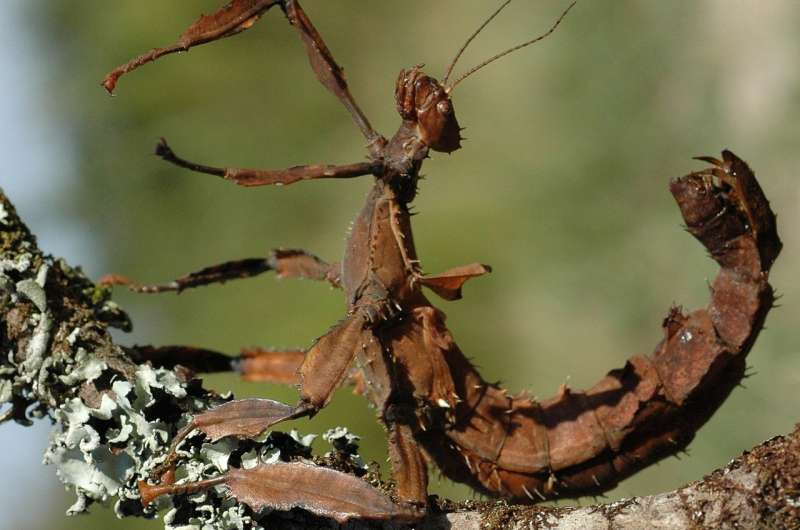Stick insects: Egg-laying techniques reveal new evolutionary map

Known for exceptional mimicry, stick insects have evolved a range of egg-laying techniques to maximize egg survival while maintaining their disguise—including dropping eggs to the ground, skewering them on leaves, and even enlisting ants for egg dispersal. Scientists have now combined knowledge on these varied techniques with DNA analysis to create the best map of stick-insect evolution to date. Contrary to previous evolutionary theories based on anatomical similarities, the new analysis finds the first stick insects flicked or dropped their eggs while hiding in the foliage. It also finds that geographically isolated populations of stick insects are more likely to be related than those with similar features. The research, published in a special issue on stick insects in Frontiers in Ecology and Evolution, takes us one step closer to understanding these enigmatic creatures.
"While the evolutionary history of most insect groups is well documented, stick insects have been hard to classify. Our new analysis has made great strides, showing that the evolution of stick and leaf insects cannot be solely based on anatomical features," says Dr. James A. Robertson, based at the Animal and Plant Health Inspection Service and affiliated with the Brigham Young University, USA. "Linking their wide-variety of egg-laying techniques to their evolutionary history, we find that flicking and dropping eggs is the oldest strategy from an evolutionary perspective."
Stick insects are increasingly popular in the pet industry on account of their remarkable size, bizarre appearance and gentle nature. They are the only insects where each species has an individual egg form. In the 1950s, scientists based stick-insect evolutionary theories on the traditional method of examining subtle changes in anatomical features. However, this method could not explain why distantly-related species—for example those separated by faraway continents—often shared very similar features.
Using DNA analysis and linking these findings to their variety of egg-laying techniques, Robertson and his colleagues created their own map of stick-insect evolution. As well as revealing that species geographically isolated with each other were more likely to be related than species that looked similar, the results challenged previous theories on how stick-insect egg-laying strategies evolved.
"Stick-insects were thought to evolve from a ground-dwelling adult form that deposited its eggs directly in the soil. We show that ancestral stick-insects actually remained in the foliage and dropped or flicked their eggs to the ground, a technique employed by most of these insects as a strategy to remain in disguise," explains Robertson. "The hardening of the egg capsule early in the evolution of stick insects represents a key innovation allowing further diversification."
This hardened capsule allows the egg to survive falls from the canopy, to float on water and to pass through the intestines of birds. A further innovation, exclusive to stick insects that flick or drop their eggs, is a food-filled cap on the egg that attracts ants, who then disperse it much further than a female stick insect could achieve on her own.
Robertson continues, "Stick insects have then adapted to new micro-habitats, which involves changing how their eggs are deployed and dispersed. There are several independent examples where species have evolved to adapt to a ground or bark dwelling habitat by depositing their eggs in the soil or in bark crevasses. Other populations have independently evolved gluing strategies, with one of these diversifying further by burying their eggs, skewering them in leaves or producing a sophisticated egg sac."
This new research demonstrates that molecular data can begin to shed light on the evolution of these enigmatic creatures, with more to be revealed.
Robertson explains, "We hope to investigate how and when key innovations in stick insect evolution occurred, how widespread these traits are and where geographically they evolved."
More information: James A. Robertson et al, Evolution of Oviposition Techniques in Stick and Leaf Insects (Phasmatodea), Frontiers in Ecology and Evolution (2018). DOI: 10.3389/fevo.2018.00216
Provided by Frontiers





















